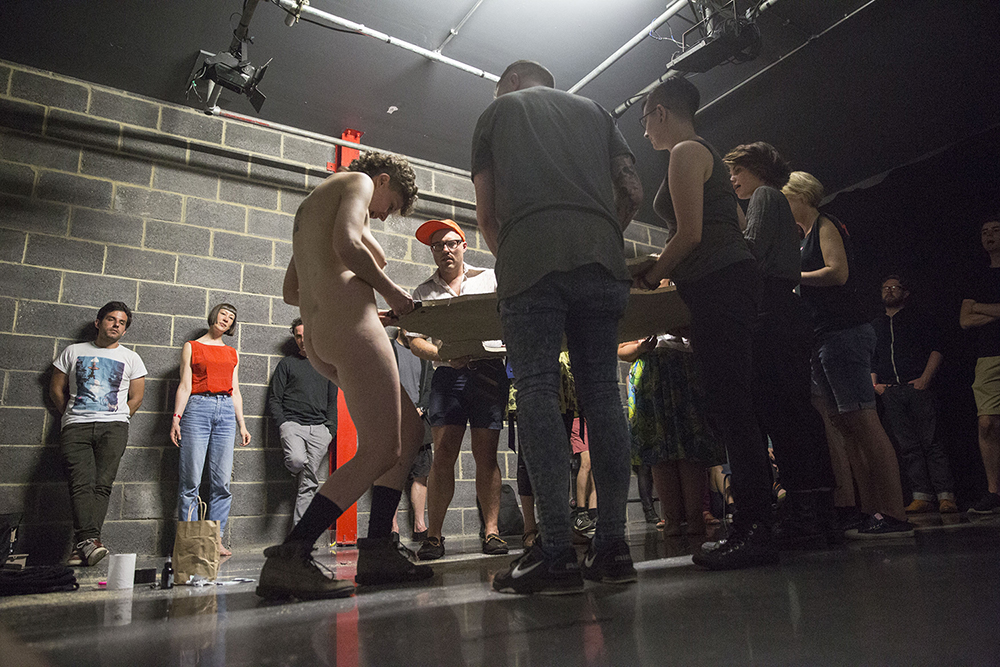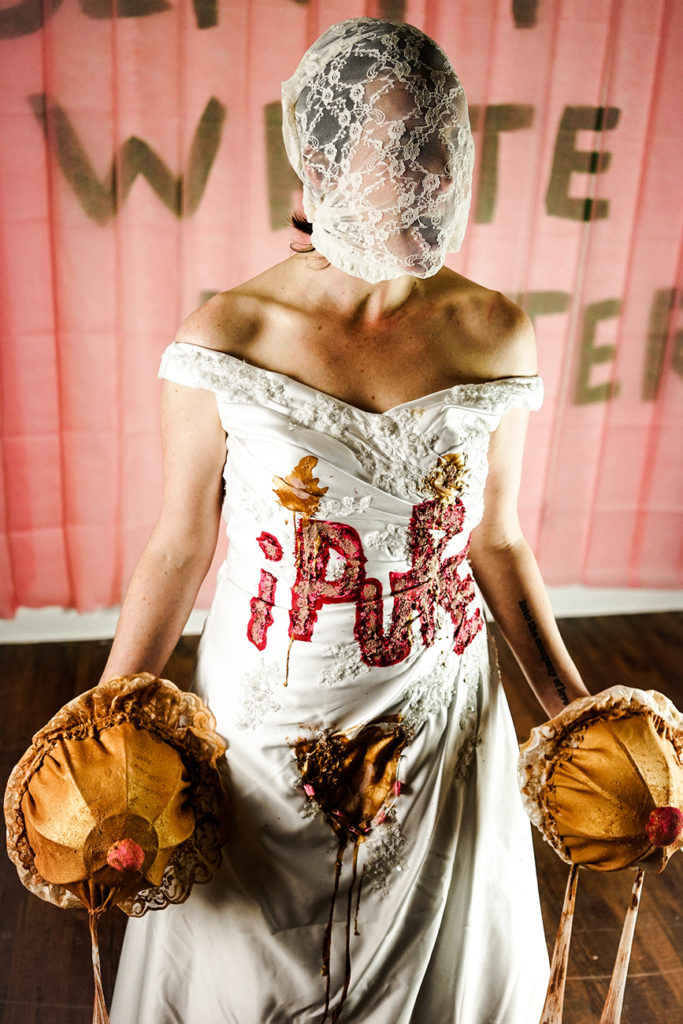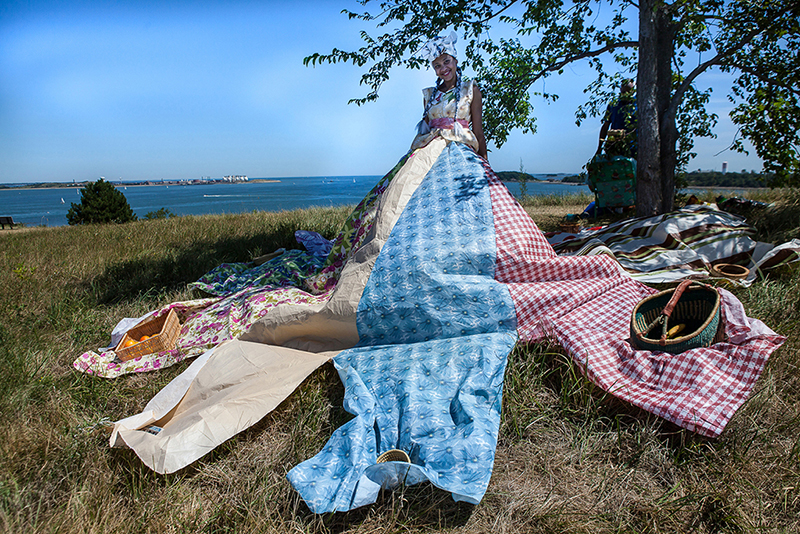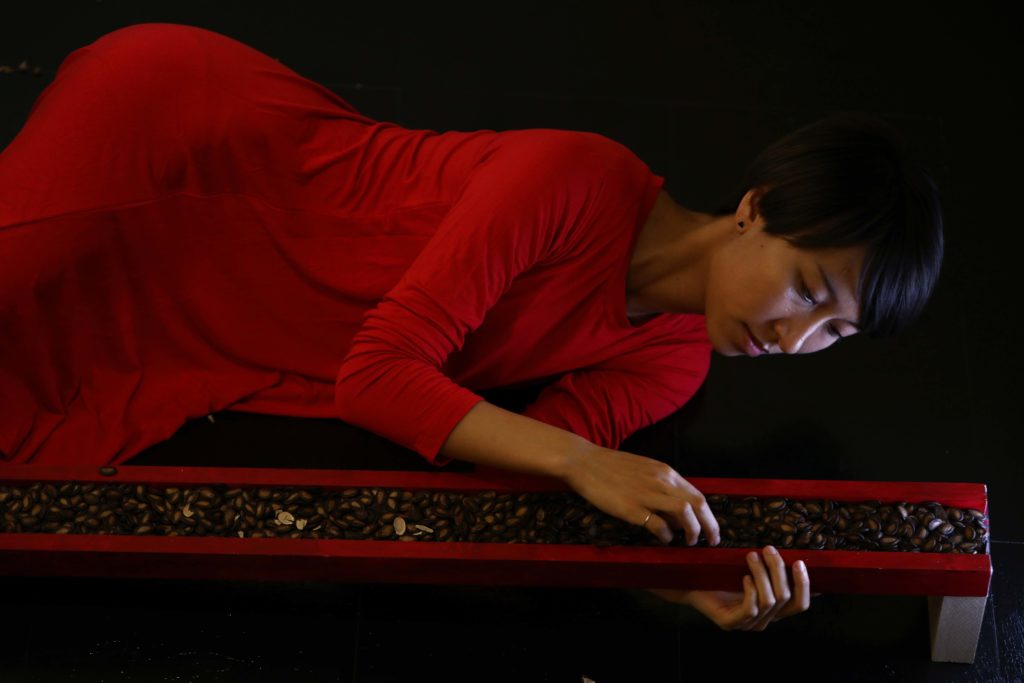Each week we feature 7 artists from Art in Odd Places 2018: BODY NYC.

Jessica Blinkhorn, Dare Me
Jessica Elaine Blinkhorn
1. Tell us about yourself and your project for AiOP BODY 2018:
I am an artist from Atlanta, Georgia who is living with a disability. My disability, however, does not define who I am as a person, but it does assist with creating my visual narrative(s). As an artist who is living with a disability I offer viewers insight into my situation and provide them with answers, or, give them the opportunity to answer questions they might have with regard to the community of people I proudly represent. This is done in both my visual and performance art pieces. I, oftentimes, disarm the viewer(s) by serving them a dish of southern sass with a side of cheeky confidence and finishing off with hemlock truths – no one is perfect, we are all struggling to find our place, and life ends, at sometime, for all so enjoy yourself, others, and laugh more than cry.
I will be presenting a two-part performance at AiOP that redefines the struggle of creating perfection to hide ones flaws and self accommodation at the expense of formal etiquette.
2. What does the theme BODY mean to you?
Body, to me, means finding autonomy. I know my body is mine, it belongs to me, but there is a disconnect within myself caused by the nature of my disease. As I age, I grow weaker and more rapidly than most aging. This, in turn, renders me more dependent on others and less independent.

Esther Neff, The Scraping Shape of the Socially Cyclomythic Womb, 2016. Photo Credit: Julia Bauer, Courtesy of Tempting Failure
Esther Neff
1. Tell us about yourself and your project for AiOP BODY 2018:
PUBLIC GRANT is an act of institution, enacting grant-making as a “populist” staging: 1. public participants propose artworks and pay an application fee of $1, 2. public participants vote on proposals to decide a winner of grant monies gathered from the application fees, 3. my body operates as the autonomous administrating embodiment through which these activities institute a “public grant.” This form combines “cutest baby” and “best drawing” contests from Midwestern grocery store pinboards with non-profit grant making processes, which both tend to reveal paradigmatic values, qualification schemas, and (politicized) aesthetics. Like much of my work, PUBLIC GRANT performs institution (as a verb), seeking less to “criticize” than to (artificially/intentionally) stage critical processes.
My projects are often realized collaboratively through/as three instantiating entities: Panoply Performance Laboratory (PPL), Brooklyn International Performance Art Foundation, and PERFORMANCY FORUM.
2. What does the theme BODY mean to you?
I am interpreting the theme via embodiment of “instituting public bodies.” Live performance inherently puts “the” visceral meat body in tension with other types of performing bodies, including “body politic,” and “bodies of knowledge,” also meaningful in their materialization of matter(s).

Deborah Castillo, Alien Stamped, 2017, Video still credit: Jose Dao
Deborah Castillo
1. Tell us about yourself and your project for AiOP BODY 2018:
In my practice I try to project a critical space that mirrors the contradictions of the context I live in. My role as an artist becomes a problematic one, as I am constantly bouncing between my individual body and the expectations social conventions put on my persona. I explore these concepts through performance, sculpture, installation, video and photography.
Alien Stamped is a body of work that addresses the stereotypes attached to immigrants and those without power. I analyze the way women have been socially labeled. I propose a way of writing that is performative and uses the body.
In my performance, I stamp the floor of 14th st with words that are used to describe latinas or immigrants in USA, culminating in a site-specific, urban action.
2. What does the theme BODY mean to you?
My performative body work is a constant evaluation of social, political and cultural issues, often referencing the Americas, pointing to the tension between power, femininity, desire and society.
 Meg Stein, Dirty White Matter, 2018. Photo Credit: Derrick Beasley
Meg Stein, Dirty White Matter, 2018. Photo Credit: Derrick Beasley
Meg Stein aka Dirty White Matter
1. Tell us about yourself and your project for AiOP BODY 2018:
Dirty White Matter explores and mutates cultural ideas of whiteness and femininity using sculpture, performance, and group discussion. It seeks to de-purify white femininity and increase accountability to POC. During the festival portion of AiOP BODY Mae Rumble, my performance alter-ego, will perform with costume, sculptures, and materials. When she is not performing she will engage passersby in hands-on activities, questions, and points of discussion.
Our world is saturated with imagery that conflates white femininity with value judgments such as “pure” or “ideal.” Consider one of the many images that show the whitewashing of Beyoncé or Gabby Sidibe in beauty-related advertisements. White women in particular, need to claim, dissect, & transform the ways in which we benefit from these cultural conflations & how they’re used to justify violence towards POC. As a white female, I want to use art to challenge these realities and dismantle the way we idealize white, female bodies.
2. What does the theme BODY mean to you?
As a white, cis-female, hetero artist, BODY means dismantling and transforming dominant cultural narratives of white female bodies as beautiful, pure, clean, innocent, and ideal. It means mutating the ways white females are seen-by themselves and others-as living embodiments of these value judgments.

Jodie Lyn-Kee-Chow, Gypsies’ Picnic: The Veins of Oya was Always Here, 2014-15. Photo Credit: Vela Phelan
Jodie Lyn-Kee-Chow
1. Tell us about yourself and your project for AiOP BODY 2018:
Jodie Lyn-Kee-Chow (b. Manchester, Jamaica) is an interdisciplinary artist showing internationally with a BFA w/ honors from NWSA University of Florida, and a MFA from Hunter College, CUNY. Awards include Culture Push, Franklin Furnace, Rema Hort Mann (A.C.E), and N.Y.F.A. Lyn-Kee-Chow often explores performance and installation art, which draws from the nostalgia of her homeland, folklore, fantasy, consumerism, spirituality, and nature’s ephemerality. She lives and works in Queens, N.Y.
For AiOP BODY, the artist wears a dress with a long train followed by several picnic attendants who walk with her to the sound of drumbeats. Once settled all are invited to sit on her picnic dress where they may eat their lunch and take orders for the fruit that’s offered. The goal of this work is to create a shared multi-cultural dining and leisure experience in New York City where people from all walks of life are invited to gather and converse harmoniously.
2. What does the theme BODY mean to you?
Body is microcosmic and macrocosmic. It is comprised of many parts coexisting in a space. It takes a ‘body’ of people to feed one body. The body is the person, the family, the country, the world, the universe. The body a migratory being. The body is always moving.
*This work is made possible, in part, by the Franklin Furnace Fund supported by Jerome Foundation, The SHS Foundation, and the New York City Department of Cultural Affairs in partnership with the City Council.

Pei-Ling Ho, Absence of Three, 2017
Pei-Ling Ho
1. Tell us about yourself and your project for AiOP BODY 2018:
In my works, I often re-examine my family structure within the context of the patriarchal Chinese culture, and visualize the painful emotions hidden under the skin. I am very intrigued by the possibility of expressing the “forbidden” emotions, such as anger and depression.
In Absence of Three, I rebuild the complex relationship of three family members: father, mother, and myself. The video, recording from my parents’ love letter, and the interaction with viewers of melon seeds, create a family scene in our daily life in which everyone in the family is just totally absent.
2. What does the theme BODY mean to you?
In this participatory performance, I consciously build a structure between family members and explore themes of absence, intimacy, and patriarchal power- which can actively engage the public. BODY is a discovery of people’s mental and physical relationship within the structure.

Claus Hedman, Documentation of Intimacy: Purchase/Contamination, 2018. Photo Credit: Claus Hedman
Claus Hedman
1. Tell us about yourself and your project for AiOP BODY 2018:
Questions of our being-in-the-world have always been at the core of my work. Currently based in Amsterdam and working as an escort, questions of intimacy is of particular interest. My work for AiOP is part of a series, approaching the theme of body through ideas of purchase and contamination, which questions the current discourse by challenging its assumption of purity, privacy, and monogamy.
Firstly, purchased encounters are brief, anonymous, and intimate. After a kiss, the DNA of the other person remains in the saliva. With swabs, I have preserved the encounters of every person who has purchased sex from me.
Secondly, lurking behind aspects of trust and virtuousness, and the stigma of sex work, is a fear of contamination. During the festival, I invite by-passers to sit down and provide me with a mouth swab which I will then expose my body to. By doing so, I am literally using my body as a battleground to fight assumptions regarding intimacy, sex work, and the private and public.
2. What does the theme BODY mean to you?
Influenced by phenomenology, which opposes the mind-body dichotomy, I believe that the bodily memory dictates our relationship with the world around us. I find that implicit, embodied, and lingering experiences, expressing themselves physically, can be a lot more telling than thoughts and reason.

